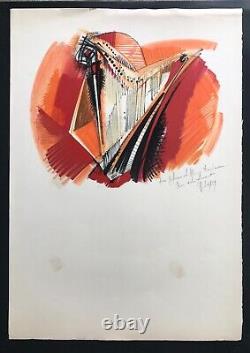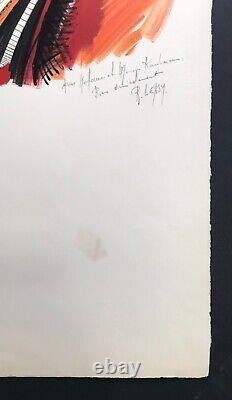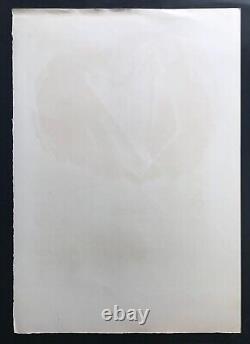
- Index
- Authenticity
- Characteristics
- Genre
- Abstract (92)
- Abstrait (363)
- Art Deco (52)
- Art Déco (109)
- Art Moderne (10)
- Art Naïf (30)
- Art Nouveau (97)
- Cubisme (26)
- Expressionism (53)
- Expressionnisme (162)
- Fauvisme (13)
- Modern (53)
- Moderne (18)
- Naive Art (21)
- Pop Art (40)
- Street Art (62)
- Streetart (87)
- Surrealism (23)
- Surréalisme (103)
- Symbolisme (14)
- Other (1419)
- Style
- Support
- Type
Roger LERSY The signed and dedicated lithograph harp








Title of the artwork: "La harpe" from his series "rythmes et danses". Technique and support: Lithography on Arches paper. Details: Signed at the bottom right and dedicated "For Mr.
Dimensions: 74 x 52 cm. The lithograph is a bit faded, which is quite normal for a lithograph from the late 1950s. Some creases at the top (see photos), which will disappear once the lithograph is framed with a mat... Certainly some traces at the bottom from a previous framing (see photos). French painter born in 1920 in Paris.
He was a painter, lithographer, and composer. He died in Forges-les-Bains (Essonne) in 2004. He belonged to the École de Paris and the Jeune peinture movement. Studying the piano from a young age, Roger Lersy, the son of a decorator, attended the École supérieure des arts appliqués Duperré in Paris after his schooling for a period of three years.Having started to paint, he then worked as a decorator, while also pursuing higher musical studies with Noël Gallon between 1950 and 1954. After 1954 (when galleries in Paris and abroad began to exhibit his work regularly), he continued to practice both painting (canvases, watercolors, tapestry designs) and music.
From 1961 to 1968, Roger Lersy lived in the United States. From 1970 onwards, he held numerous solo exhibitions in Paris, London, Geneva, Houston, Los Angeles, and New York, among others. Roger Lersy was initiated as a first-degree Freemason in the Scottish Rite in 1979, in the Grand Val lodge, which met at the time in Perreux-sur-Marne, Orient of Sucy-en-Brie (later Orient of Créteil, Val-de-Marne) of the Grande Loge de France, whose actor Jean Franval was once the grand provincial inspector. Balancing two careers, Roger Lersy left behind paintings that are seen as full of "rhythms and tremors[.] In his canvases, the motif unfolds in a melancholic line with well-coordinated chords, pauses, and cadences.Lersy could be defined as a baroque expressionist". According to Bernard Dorival, Roger Lersy, along with Gabriel Dauchot, Jean Commère, and Raymond Guerrier, is among "the most notable champions of this expressionism that follows in the footsteps of Bernard Buffet's miserabilism". Less known aspects of Roger Lersy include his interest in mosaic, sculpture, stained glass, and creations for public (town halls, colleges, etc.
), private (businesses), and religious buildings. Roger Lersy does not belong to musicalism in painting in the sense that "musicalism" historically refers to a group of painters formed around Henri Valensi from 1932. However, if we agree with Raymond Bayer in his Aesthetic Review that "musicalism is not a school but an art doctrine, a set of knowledge constituting a system," the term can then, by extension, be associated with Roger Lersy, where music and aesthetic effects (his arabesques and cross-hatched lines of "incredible virtuosity" for one, his striped backgrounds always of "spectacular virtuosity" for the other) remain in constant connection.Roger Lersy's son, François Lyres, is also a draftsman, painter, and musician.

